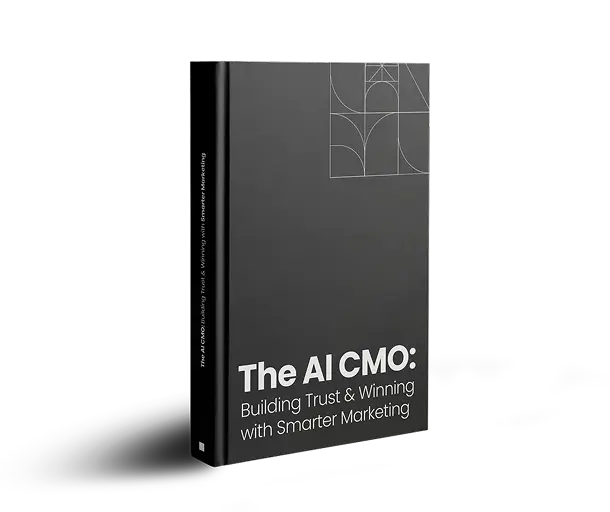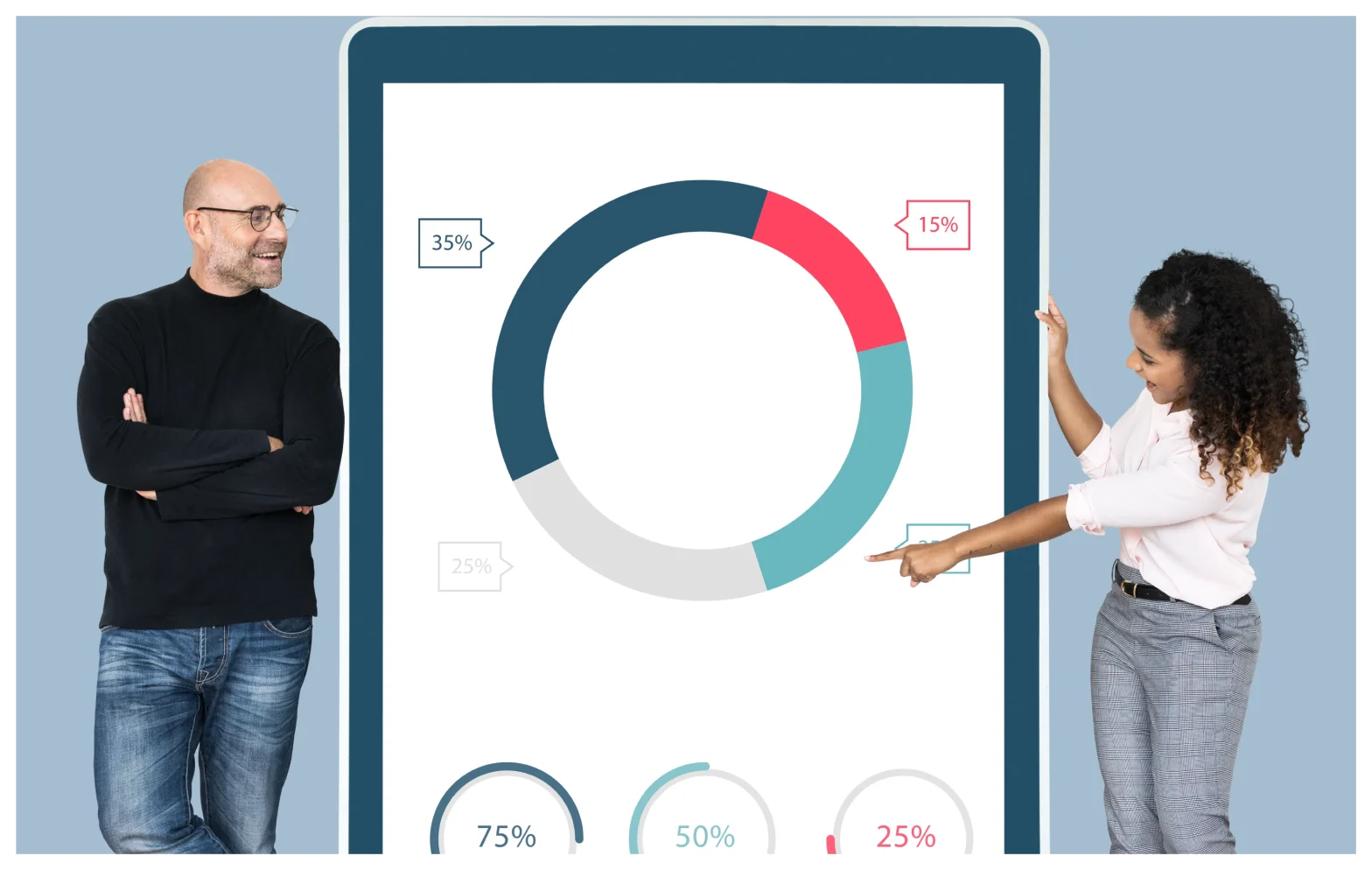
Introduction
Do you often run online business ads? Then, you must have already heard of programmatic display ad terminology here and there.
This isn’t any new technology. Instead, it’s almost 15 years old advertising technology that has given a great push to marketing automation workflows.
In 2020, the US programmatic display ad market was the largest with $70 billion spendings, followed by China and Europe, with $23.4 billion and $19.2 billion.
Further, in 2021, it is projected that the global programmatic ads spending will reach $155 billion.
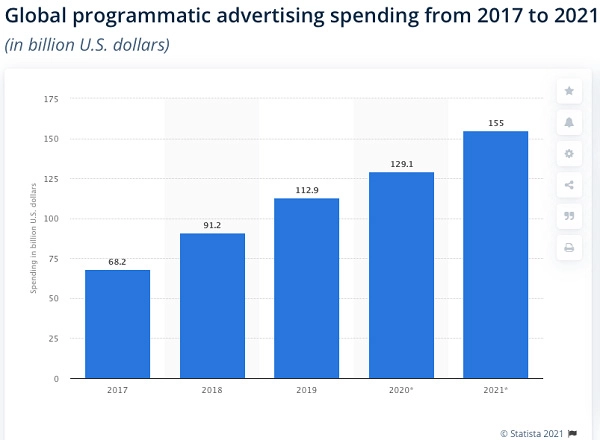
Source : Smart Insights
So, programmatic display ads are something that marketers will explore a lot in the coming days to grow online businesses. Here if you aren’t still fully familiar with programmatic ads and don’t know how they can bring higher conversions your way, this guide is for you. Just scroll down and understand how to advertise online for better returns!
What is Programmatic Advertising?
To put it simply, programmatic advertising is the process of using digital software to buy ads. There are no human efforts involved in programmatic advertising.
All the traditional methods of requesting quotes, proposals, and tenders are replaced with algorithms in programmatic marketing.
Although, it isn’t complete automation of the advertisement buying process. It’s just a better optimization of marketers’ time and ads’ performance.
For example, traditionally, marketers have to place insertion orders or add ad tags manually, which can take up lots of time. But now, with programmatic advertising, all labor-intensive work is quickly and effectively handled by machines.
However, human intelligence is always required to plan and optimize ads according to accounts preferences. Besides human understanding, programmatic-centric software is required to create highly optimized and targeted ads.
So, programmatic display ads are the by-product of human-touch and machine intelligence that can help businesses with better lead generation.
How Does Programmatic Display Ads Work?
It’s alright if you haven’t yet got the hang of the programmatic ads working process; we don’t blame you. It is indeed a bit of a technical process, and it takes some time to fully understand the concept.
For your ease, we have here broken down the entire programmatic display ads process into 7 easy steps:
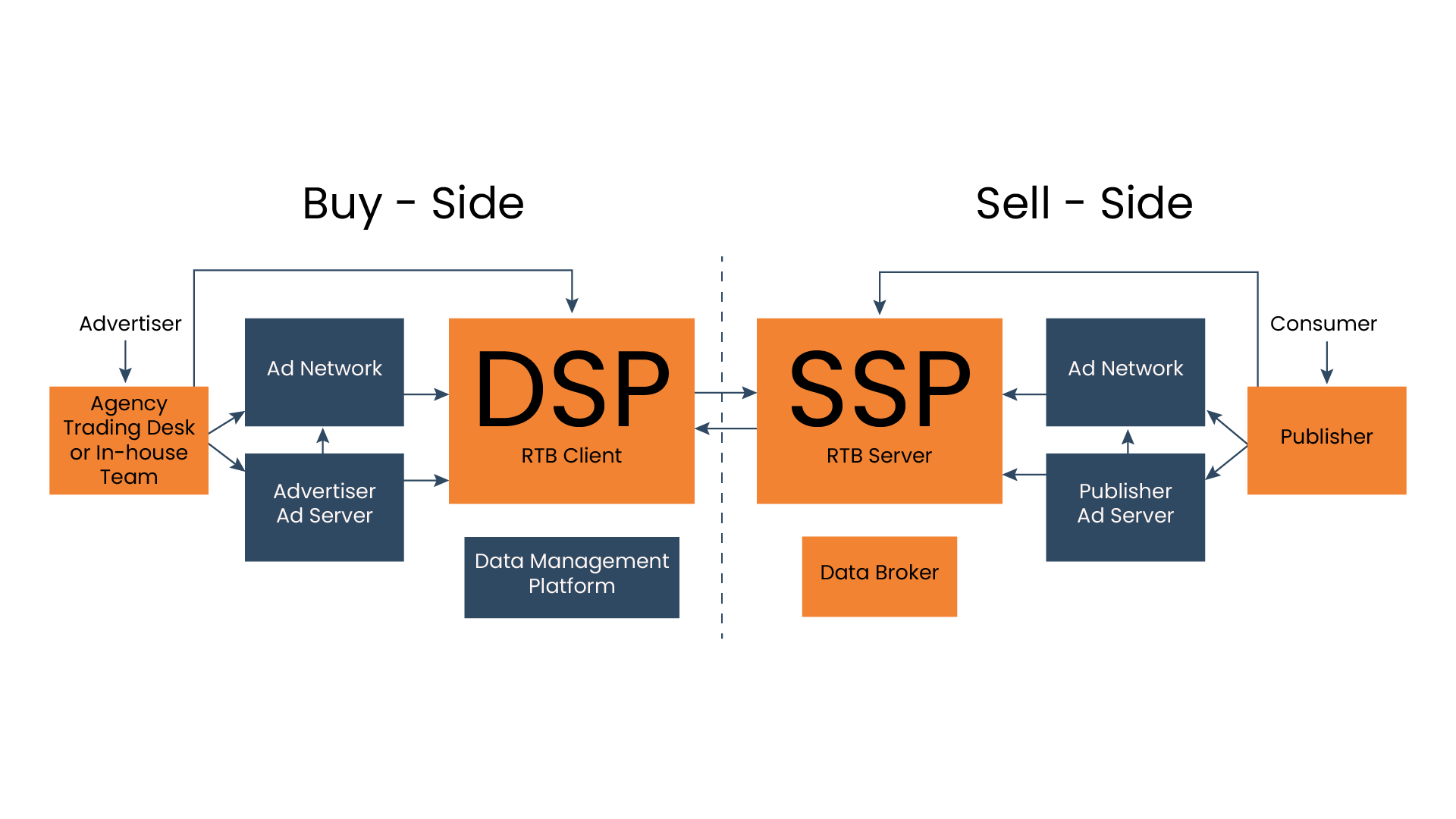
Step 1. When a visitor lands on a business website that uses programmatic ads, it will automatically start bidding ads to this particular account.
Step 2. Now, the publisher creates the ad space for the visitor on the supply-side platform (SSP). The SSP here tells advertisers about the site, visitors, and the ad space that facilitates the demand-side platform (DSP) to make their bid.
Step 3. After receiving the ad space information, the SSP analyzes the user’s cookies to retrieve information on the user’s interest, geography, demography, and other relevant details.
Step 4. Next, the DSP verifies the user information provided by the SSP. DSPs help advertisers to find the right ad space suiting their budget and targeted parameters. It also assigns the perfect ad placement based on user and site characteristics.
Step 5. Now, DSPs make the ad bids on behalf of advertisers. All this happens in real-time; therefore, programmatic display ads are also known as real-time bidding (RTB).
Step 6. After receiving bids from various DSPs, the SSP analyzes them all and then picks the winning ad. SSPs use numerous strategies here to find the best ad, including Waterfall bidding, Header bidding, and Client-side bidding. Mostly, header-style bidding is considered the best and fair option.
Step 7. Finally, now the SSP displays the winner ad on the publisher’s website in real-time. This entire process completes within milliseconds that the visitors won’t even realize so much happening behind the scenes to get an ad for them.
Is Programmatic Display Advertising Beneficial for Your Business Today?
Yes. Definitely, programmatic display ads are highly beneficial for your business today.
This advertising method has been working very well in the online marketing realms for the past few years. In fact, the digital display advertising spending budget has increased seven times between 2012 to 2021.
This giant surge in the automated advertising system is mainly seen because of users’ demand for more personalized experiences.
According to a survey conducted by Epsilon and GBH Insights among 1,000 US adults, 80% of people prefer a personalized retail experience. All thanks to pioneers like Amazon, customers’ desire for personalized experience has increased dramatically.
Here programmatic display ads use real-time online users’ intent data and allow advertisers to create account-based marketing solutions targeting each potential account.
Plus, today, with private exchanges offering buyer’s intent data, marketers have gained more control over their spending. In eMarketer’s principal analyst, Lauren Fisher‘s words, “Private setups give buyers and sellers greater control over their automated buy.”
All in all, programmatic display ads are what marketers use today and will use tomorrow to increase ad performance and reduce marketing budgets.
How Programmatic Display Ads Offers Higher Conversions
There are several good reasons behind using programmatic marketing to boost your conversion rates. In fact, 68% of the digital advertising budget will be dedicated for programmed marketing across all channels.
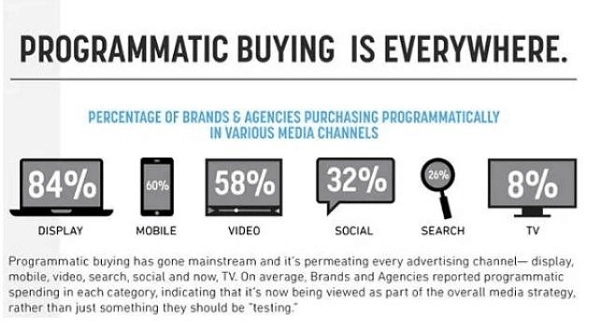
Source : Cardinal digital marketing
However, you should not use programmatic display ads because everyone is using them. You should adopt programmatic marketing because it helps to:
Target the Relevant Users
Programmatic display ads allow you to target the right people based on their preferences. This advertising method facilitates marketers to target audiences based on their location, age, and many other preferences.
Here The Economist used programmatic advertising like a pro and even received a Masters of Marketing award for it. In 2015, The Economist designed 60 creatives to target around 650k prospects.
The Economist programmatic ad campaign was pretty simple. They analyze the current story, an account reading, and similar to the story, they publish an ad.
Here when a reader clicked on The Telegraph story related to the Mediterranean migrant death oil, on the same page, they get an ad saying, “Why has the Mediterranean turned into the Dead Sea?”
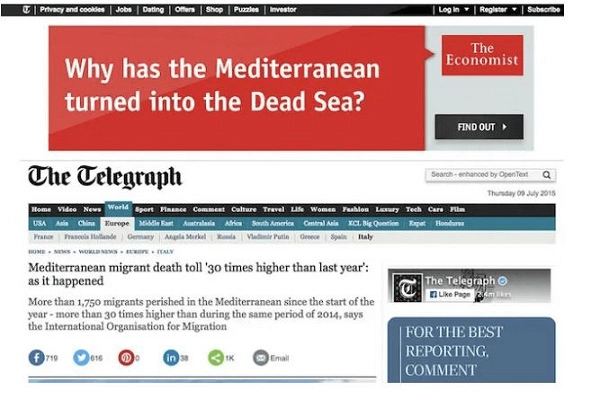
Source : Cardinal digital marketing
With this innovative account-based marketing campaign, The Economist converted more than expected, such as:
- 6 million unique actions
- 1 million new viewers
- 650,000 potential leads
- 64% of awareness among the US audiences
- 10:1 campaign ROI
- 9,500 new subscribers and so much more.
Higher Rate of Return
Digital marketing is a big thing today. Therefore, the digital advertising spending worldwide between 2019 to 2024 is expected to go double.
Along with the spending, competition in the digital advertising sector is also growing. That means you can’t expect a high ROI with traditional advertising approaches.
Since programmatic display ads are driven by artificial intelligence (AI), they are programmed to learn and get better constantly. On top of it, when you are targeting only the potential users instead of a large group, your advertising budget will automatically go down.
To gain higher ROI, Google also started using programmatic ads to promote its Google Search App in 2014. This campaign reached 30% more people and resulted in a 30% lower cost per thousand impressions (CPM). That’s not it. Google also received a 50% increase in brand awareness.
All this happened in 2014 when programmatic marketing wasn’t developed that much. So, you can imagine if you today do something at the caliber of Google campaign, how much better ROI you can get?
Reach Across Multiple Search Engines
One of the major drawbacks of traditional advertising channels like AdWords and Bing is that you are targeting a single search engine only at a time.
For instance, if you run display ads on AdWords, your ad will only show on Google-friendly sites. Indeed, Google is the biggest search engine in the world, with 92.47% of the market share. In comparison, Bing stood at 2.31% and Yahoo at 1.53% of the global market share.
But, there’s still 8.53% of sites that you are missing with only advertising on AdWords. This, in return, will reduce your conversion rate.
Fortunately, programmatic advertising lets you access numerous ad networks, publishers, and exchanges. Additionally, you can run programmatic ads in various formats, including interactive visuals and personalization.
You can also create mobile, in-videos, and even ABM ads on social media using programmatic advertising. So, when you can target your audience through different formats, this will surely give a big push to your business reach and growth.
Ease in Reporting And Analyzing
As we have already established above, programmatic display ads use AI. Thus, they can generate reliable and actionable data-rich reports. Depending upon your campaigns, targeted market, and buyer’s behavior, automated ads can provide better data for smarter decision-making.
You can even analyze your customers at the individual level with this marketing solution. If you combine your ad reporting data along with your buyer’s intent data, you can:
- Fully automate your marketing process
- You can promote your brand on several different networks
- Also, you can adjust your ads in real-time
5 Steps to Create a Programmatic Ad Campaign
Now, you know how programmatic display ads can bring higher conversions your way. So, you must be excited to launch your programmatic ad campaign!
Therefore, without any ado, let’s see how you can customize your programmatic campaign:
1. Define Your Objectives
Like any other advertising campaign, you have to first clarify your objectives. Ask yourself:
- Why are you actually using a programmatic advertising campaign?
- What do you want to achieve with programmatic ads?
Once you honestly answer these two questions, you can achieve maximum advertising ROI. For example, when Nestle ran a programmatic ad campaign, its main goal was to improve the sale of its coffee machine and reach new users. As a result, 91% of Nestle ads brought new users.
2. Select Your DSP Partner
To run a programmatic campaign, you have to first select the right DSP. It will provide you access to ad space, placements and allow you to set bids.
Today, numerous DSPs are available, such as Google Marketing Platform, Facebook Ads Manager, Amazon Advertising Platform, and many more. So, you should properly research all the popular DSPs before selecting the best one for your campaign.
3. Optimize Your Ads
Before publishing your ads, you should optimize your creatives and other ad content. The common programmatic ad optimization variables are:
- A/B testing
- Audience segmentation
- Placements
- Channels
- Devices
- Ad format and frequency
- Time
- Bid adjustment
4. Select Your Publishing Partner
Your optimized and tested ads can only perform well when they are published on the right sites. To select your ad publisher, test each website on the following grounds:
- Conversions
- Sales
- Engagement
- ROI
- Click-through rate and other vital metrics.
5. Constantly Track and Measure
For the success of your objectives and goals, constant monitoring and tracking of the programmatic ad campaigns are essential.
You should measure the publishers’ performance and analyze how well they performed in the context of KPIs. Based on the campaign analysis, you can modify your creatives, ad bidding, and other strategies. If your publisher isn’t doing well, you can replace them before it gets too late.
What Future Holds for Programmatic Display Ads
Programmatic display ad technology isn’t something new, but this technology never fails to surprise because of frequent developments.
In the last 15 years, marketers have witnessed many new changes and improvements in programmatic advertising, including AI, creatives, and much more.
And, in the coming days, you should be prepared to observe many new modifications in the programmatic display ads, such as:
- GDPR regulations will likely remove some restrictions and empower advertisers to access buyer’s personal data.
- Cookie-less tracking will become more powerful and effective.
- AI influence will expand in programmatic creatives.
- New programmatic marketing agencies will emerge.
Overall, programmatic advertising will map out further and become a prominent part of the digital marketing industry. So, if you aren’t paying attention to programmatic ads yet, to convert more, start today.
You have practically learned everything in this post that you need to start with programmatic display ads and enjoy higher conversions altogether. But if you wish to learn more on this topic or other digital marketing topics, stay tuned.
Our blog
Latest blog posts
Tool and strategies modern teams need to help their companies grow.

Video has emerged as one of the most effective tools to cut through the noise and con...

The way B2B buyers research, engage, and decide has changed and so must the way marke...

Channel marketing helps B2B companies grow by partnering with third-party sellers. It...






